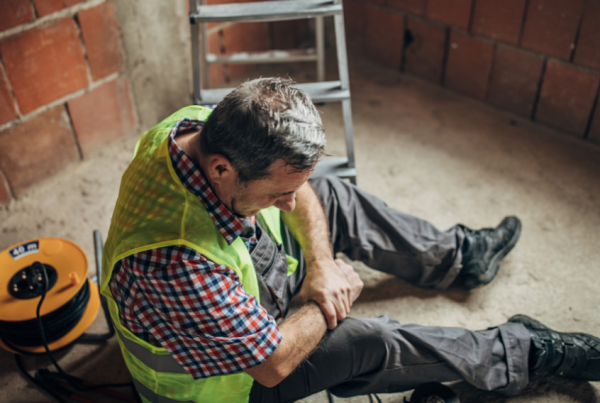Weight Lifting Injuries
Move Better. Live Fuller. Your Wellness Journey Starts Here.
Schedule a FREE Discovery Call!
About Weight Lifting Injuries
Weight lifting injuries refer to injuries that occur during training or exercises involving weights. “Weight lifting” can simply refer to a form of strength training using weights, whereas “weightlifting” can refer to a type of sport that involves lifting weights with specific techniques or heaviness. Below, we’ve outlined some different activities that involve weights:
General weight lifting: Also referred to as “weight training.” General weightlifting helps maintain good musculoskeletal health and in some cases allows individuals to achieve a desired physique.
Bodybuilding: Intense training to achieve an ideal or aesthetically pleasing physique. Bodybuilding can include a variety of strength training methods, including the use of weights.

Powerlifting: A competitive sport of strength, where individuals challenge themselves to lift significant amounts of weight during movements including the squat, bench press, and deadlift.
Olympic weightlifting: A specialized form of lifting that, similarly to powerlifting, requires great strength. However, this sport often focuses on technique and different movements from that of powerlifting.
Any of these types of weight lifting activities require effort from your musculoskeletal system. This means that without good form, technique, muscle balance, and flexibility, any of these sports can cause injury.
You may be thinking, “I’m not an Olympic weightlifter, surely I won’t have to worry about injury that much.” In reality, any form of weight lifting, even simple exercises at home, can cause injury if not done correctly. Using weights can involve many parts of the body and many structures in the body—your muscles, tendons, joints, bones, and ligaments. Even just having the wrong posture while lifting weight can create chronic injuries!
The areas affected by weight training will depend on the type of lifting you’re performing, such as deadlifts, bench presses, overhead lifts, or even just working with dumbbells. Some common areas of injury in relation to weight training include the wrists, knees, shoulders, lower back, and elbows.
More specifically, weight lifting injuries commonly include the following:
- Strains and sprains
- Fractures
- Overuse injuries
- Spinal injuries
- Tendinitis
- Joint dysfunction
What Causes Weight Lifting Injuries?
Weight lifting injuries can be caused by many factors. This type of training, especially with heavier weights, requires a lot of strength and mobility from the body. Therefore, while acute injuries can happen from sudden accidents (such as a weight dropping), chronic injuries are especially common, such as from poor technique or overextension. Below, we’ve outlined some common causes of weight lifting injuries:
Improper Technique / Form
Lifting with poor technique can not only cause straining and chronic injuries over time, but it can also inhibit progression or results as the wrong structures and muscle groups are engaged during reps.
Overloading / Overtraining
Not properly cooling down or taking breaks in between workouts can overwork your body and cause significant fatigue. Fatigued muscles will struggle to perform, and this can lead to injury such as strain.
Inadequate Conditioning
Not properly preparing the body before any form of exercise or sport increases your risk of injury. When lifting weights, especially significantly heavy weights, preparing the body adequately beforehand is essential to preventing strain and overextension.
Muscle Imbalances or Misalignment
Lifting weights while having muscle imbalances or misalignment of the hips or spine can create painful injuries. This is especially applicable to lifting techniques that require coordination of the entire body.
Progressing Too Quickly
Trying to lift weights that are too heavy for your current level of strength or endurance can cause significant injuries. Weight lifting requires gradual, incremental changes to weight in order to safely progress to heavier lifting.
Repetitive Stress
Any movement, when done repetitively over long periods of time, can create stress on the body. When paired with poor form or inadequate warm-ups, repetitive stress is highly likely to create injury.
Physical Therapy for Weight Lifting Injuries
Physical therapy is a great form of treatment for weight lifting injuries, as they are most often musculoskeletal. For acute or chronic injuries, a physical therapist is able to address pain and swelling, restore function and range of motion, and prevent re-injury through education and training.
Additionally, any individual who engages in weight lifting can benefit from physical therapy as it can address imbalances, misalignment, low mobility, and poor technique. Addressing these physical deficits can not only lower your risk of injury, but also improve performance.
To address a weight lifting injury, your physical therapist will create an individualized plan of care that focuses on rehabilitation and prevention. This care plan will include treatments that improve your function, strength, mobility, flexibility, and technique. These treatments will enhance musculoskeletal health and allow you to return to your sport safely.
Your Hive physical therapist will begin with a thorough evaluation and examination. They’ll discuss the nature of your injury, how it occurred, and the type of weightlifting you engage in. You can also expect to discuss any relevant past injuries or surgeries.
The physical examination will allow your provider to look for swelling, bruising, inflammation, instability, tenderness, or pain. They’ll assess your muscle balance, posture, alignment, range of motion, and flexibility. Your physical therapist may ask you to perform movements or other tasks, so that they can evaluate your technique and form to identify any possible contributors to your injury.
After they complete these assessments, they’ll formulate a care plan based on your unique needs! This care plan will include a wide variety of treatment methods, such as the following:
Pain Management and Manual Therapy
Physical therapists are very skilled in providing pain-relieving treatments and modalities for weight lifting injuries. This can include temperature therapies, electrical stimulation, or manual therapies to relieve pain, reduce inflammation, improve tissue mobility.
Manual therapy is a very valuable form of treatment that can encourage muscle function, joint mobility, blood flow, and pain relief. The providers at Hive Therapy and Wellness often use methods such as dry needling, tissue scraping, cupping, and more.
Strengthening and Stretching
After identifying areas of weakness, imbalance, or tightness, your physical therapist will lead you through exercises and stretching to rehabilitate the area. These exercises and activities will start out gentle, but progressively become more challenging are your injury heals.
Your exercise plan will be curated to your unique needs and injury. There are many different ways to train with weights, so this exercise plan can cover a variety of areas. Much of the body’s muscle groups are interconnected; therefore, your physical therapist will look to correct muscle balance in multiple areas as necessary.
For example, if you experienced a back injury while overhead lifting, your physical therapist will strengthen not only your back, but also your hips, core, and pelvic floor.
Strengthening, stretching, and mobility exercises will be important for restoring your function, range of motion, and flexibility. These exercises will reduce stiffness and strain, and allow better movement overall!
Movement Training
In addition to physical training and strengthening, your physical therapist will lead you through movement training. This can include treatments like neuromuscular re-education and biofeedback, which rehabilitate your movements after injury by restoring good movement patterns and muscle coordination. With movement training activities and exercises, your physical therapist can address the following:
- Movement limitations or pain
- Compensatory patterns
- Poor technique
- Joint stiffness
- Low coordination
- Improper muscle activation
Addressing these physical limitations will reduce your risk of re-injury, and improve your performance when training.
Education and Long Term Maintenance
Education plays a large role in rehabilitation and injury prevention. Your physical therapist will be sure to teach you a variety of techniques, such as how to:
- Maintain good form and technique for a variety of different weight lifting exercises.
- Properly progress weight and difficulty during training.
- Warm up the body to prevent straining and stress.
- Cool down the body to prevent overtraining.
- Set goals and adjust training appropriately to avoid overloading.
- Maintain flexibility and strength at home with an exercise plan.
In addition to these valuable topics, your physical therapist can collaborate with your coaches, trainers, or relevant health professionals to better curate your plan of care. This will allow your physical therapy treatment to better align with your goals and other forms of training.
The physical therapists at Hive Therapy and Wellness want to help you get back to lifting weights safely and confidently so that you can reach your performance goals effectively, without the risk of injury. Therefore, they’ll modify your care plan as needed, and utilize a variety of treatments to best meet your needs. These treatments can include any of the following:
- Neuromuscular re-education
- Manual therapy
- Exercise prescription
- Dry needling
- Cupping
- Tissue scraping
- Behavioral modifications
- Therapeutic activities
- Electrical muscle stimulation
- Spinal manipulation
- Therapeutic modalities
- Biofeedback
Weight lifting injuries refer to injuries that occur during training or exercises involving weights.
“Weight lifting” can simply refer to a form of strength training using weights, whereas “weightlifting” can refer to a type of sport that involves lifting weights with specific techniques or heaviness.
Below, we’ve outlined some different activities that involve weights:
- General weight lifting: Also referred to as “weight training.” General weightlifting helps maintain good musculoskeletal health and in some cases allows individuals to achieve a desired physique.
- Bodybuilding: Intense training to achieve an ideal or aesthetically pleasing physique. Bodybuilding can include a variety of strength training methods, including the use of weights.
- Powerlifting: A competitive sport of strength, where individuals challenge themselves to lift significant amounts of weight during movements including the squat, bench press, and deadlift.
- Olympic weightlifting: A specialized form of lifting that, similarly to powerlifting, requires great strength. However, this sport often focuses on technique and different movements from that of powerlifting.
Any of these types of weight lifting activities require effort from your musculoskeletal system. This means that without good form, technique, muscle balance, and flexibility, any of these sports can cause injury.
You may be thinking, “I’m not an Olympic weightlifter, surely I won’t have to worry about injury that much.” In reality, any form of weight lifting, even simple exercises at home, can cause injury if not done correctly.
Using weights can involve many parts of the body and many structures in the body—your muscles, tendons, joints, bones, and ligaments. Even just having the wrong posture while lifting weight can create chronic injuries!
The areas affected by weight training will depend on the type of lifting you’re performing, such as deadlifts, bench presses, overhead lifts, or even just working with dumbbells.
Some common areas of injury in relation to weight training include the wrists, knees, shoulders, lower back, and elbows.
More specifically, weight lifting injuries commonly include the following:
- Strains and sprains
- Fractures
- Overuse injuries
- Spinal injuries
- Tendinitis
- Joint dysfunction
Weight lifting injuries can be caused by many factors. This type of training, especially with heavier weights, requires a lot of strength and mobility from the body.
Therefore, while acute injuries can happen from sudden accidents (such as a weight dropping), chronic injuries are especially common, such as from poor technique or overextension.
Below, we’ve outlined some common causes of weight lifting injuries:
Improper Technique / Form
Lifting with poor technique can not only cause straining and chronic injuries over time, but it can also inhibit progression or results as the wrong structures and muscle groups are engaged during reps.
Overloading / Overtraining
Not properly cooling down or taking breaks in between workouts can overwork your body and cause significant fatigue.
Fatigued muscles will struggle to perform, and this can lead to injury such as strain.
Inadequate Conditioning
Not properly preparing the body before any form of exercise or sport increases your risk of injury.
When lifting weights, especially significantly heavy weights, preparing the body adequately beforehand is essential to preventing strain and overextension.
Muscle Imbalances or Misalignment
Lifting weights while having muscle imbalances or misalignment of the hips or spine can create painful injuries.
This is especially applicable to lifting techniques that require coordination of the entire body.
Progressing Too Quickly
Trying to lift weights that are too heavy for your current level of strength or endurance can cause significant injuries.
Weight lifting requires gradual, incremental changes to weight in order to safely progress to heavier lifting.
Repetitive Stress
Any movement, when done repetitively over long periods of time, can create stress on the body.
When paired with poor form or inadequate warm-ups, repetitive stress is highly likely to create injury.
Physical therapy is a great form of treatment for weight lifting injuries, as they are most often musculoskeletal.
For acute or chronic injuries, a physical therapist is able to address pain and swelling, restore function and range of motion, and prevent re-injury through education and training.
Additionally, any individual who engages in weight lifting can benefit from physical therapy as it can address imbalances, misalignment, low mobility, and poor technique.
Addressing these physical deficits can not only lower your risk of injury, but also improve performance.
To address a weight lifting injury, your physical therapist will create an individualized plan of care that focuses on rehabilitation and prevention.
This care plan will include treatments that improve your function, strength, mobility, flexibility, and technique. These treatments will enhance musculoskeletal health and allow you to return to your sport safely.
Your Hive physical therapist will begin with a thorough evaluation and examination.
They’ll discuss the nature of your injury, how it occurred, and the type of weightlifting you engage in. You can also expect to discuss any relevant past injuries or surgeries.
The physical examination will allow your provider to look for swelling, bruising, inflammation, instability, tenderness, or pain. They’ll assess your muscle balance, posture, alignment, range of motion, and flexibility.
Your physical therapist may ask you to perform movements or other tasks, so that they can evaluate your technique and form to identify any possible contributors to your injury.
After they complete these assessments, they’ll formulate a care plan based on your unique needs!
This care plan will include a wide variety of treatment methods, such as the following:
Pain Management and Manual Therapy
Physical therapists are very skilled in providing pain-relieving treatments and modalities for weight lifting injuries.
This can include temperature therapies, electrical stimulation, or manual therapies to relieve pain, reduce inflammation, improve tissue mobility.
Manual therapy is a very valuable form of treatment that can encourage muscle function, joint mobility, blood flow, and pain relief.
The providers at Hive Therapy and Wellness often use methods such as dry needling, tissue scraping, cupping, and more.
Strengthening and Stretching
After identifying areas of weakness, imbalance, or tightness, your physical therapist will lead you through exercises and stretching to rehabilitate the area.
These exercises and activities will start out gentle, but progressively become more challenging are your injury heals.
Your exercise plan will be curated to your unique needs and injury. There are many different ways to train with weights, so this exercise plan can cover a variety of areas.
Much of the body’s muscle groups are interconnected; therefore, your physical therapist will look to correct muscle balance in multiple areas as necessary.
For example, if you experienced a back injury while overhead lifting, your physical therapist will strengthen not only your back, but also your hips, core, and pelvic floor.
Strengthening, stretching, and mobility exercises will be important for restoring your function, range of motion, and flexibility. These exercises will reduce stiffness and strain, and allow better movement overall!
Movement Training
In addition to physical training and strengthening, your physical therapist will lead you through movement training.
This can include treatments like neuromuscular re-education and biofeedback, which rehabilitate your movements after injury by restoring good movement patterns and muscle coordination.
With movement training activities and exercises, your physical therapist can address the following:
- Movement limitations or pain
- Compensatory patterns
- Poor technique
- Joint stiffness
- Low coordination
- Improper muscle activation
Addressing these physical limitations will reduce your risk of re-injury, and improve your performance when training.
Education and Long Term Maintenance
Education plays a large role in rehabilitation and injury prevention. Your physical therapist will be sure to teach you a variety of techniques, such as how to:
- Maintain good form and technique for a variety of different weight lifting exercises.
- Properly progress weight and difficulty during training.
- Warm up the body to prevent straining and stress.
- Cool down the body to prevent overtraining.
- Set goals and adjust training appropriately to avoid overloading.
- Maintain flexibility and strength at home with an exercise plan.
In addition to these valuable topics, your physical therapist can collaborate with your coaches, trainers, or relevant health professionals to better curate your plan of care.
This will allow your physical therapy treatment to better align with your goals and other forms of training.
The physical therapists at Hive Therapy and Wellness want to help you get back to lifting weights safely and confidently so that you can reach your performance goals effectively, without the risk of injury.
Therefore, they’ll modify your care plan as needed, and utilize a variety of treatments to best meet your needs. These treatments can include any of the following:
- Neuromuscular re-education
- Manual therapy
- Exercise prescription
- Dry needling
- Cupping
- Tissue scraping
- Behavioral modifications
- Therapeutic activities
- Electrical muscle stimulation
- Spinal manipulation
- Therapeutic modalities
- Biofeedback
You can learn more about these treatments on our Treatments Page.





